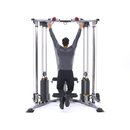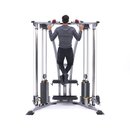Once upon a time, muscle was only for bodybuilders and pro wrestlers. Today, we know better! Man or woman, young or old, we can all benefit from having more lean mass on our bones. Whether you want to be able to play all day without wearing out, do awesome stuff you couldn't do before, or just look your best, muscle can help.
So how do you get it? You follow a muscle-building program for a few months. End of story, right? Hardly!
Far too many people who make the decision to add lean mass think it's just about punching the clock at the gym and doing what their program says. Fast forward three months, and despite their best training and dietary efforts, they're still the same damned size. Forget impressive arms and legs; nothing's growing, and it really sucks!
If that sounds familiar, these five tips will help you shift out of idle and into the fast lane to gains. This is the important stuff that your training program won't tell you!
Growth Tip 1: If you measure nothing else, measure protein
In order for your muscles to grow, they have to repair themselves from the stress you put them under when you lift weights. Muscle protein synthesis (MPS) is the system that repairs damaged muscle cells and builds new ones. Muscle protein breakdown (MPB), on the other hand, occurs when your body breaks down protein to use for energy.

To ensure your muscles have enough accessible protein to utilize for synthesis, and to minimize the amount your body uses for energy, you're going to have to eat a lot of it.
To ensure your muscles have enough accessible protein to utilize for synthesis, and to minimize the amount your body uses for energy, you're going to have to eat a lot of it. In my experience, it's best to eat a meal that includes 20-30 grams protein about every 2-3 hours.
You may have heard that kind of recommendation before, so let me ask you: Are you following it? And how sure are you about how much protein you're eating? Plenty of people think they're consuming a lot, but once they get out the scale and click over to a nutrient database, the numbers tell a different story.
Even if you don't measure any other macronutrients, you should be measuring your protein. And keep doing it until it becomes second nature and you can eyeball that 30 grams the moment you stumble into the kitchen and crack the fridge for a late-night feeding frenzy.
The type of protein you eat matters, too. Some protein sources are "incomplete," which means they lack one or more of the amino acids needed to build new cells. Complete protein sources, on the other hand, have all the amino acids necessary for you to build muscle. Complete protein sources include beef, poultry, fish, dairy (like whey and casein), and soy.
If you're a vegetarian, don't worry. There are plenty of complete vegetarian-friendly protein sources for you to add to your muscle-building diet.
How to Make a Complete Vegetarian Protein
Just match an incomplete protein from Column A with one from Columns B or C!

A: Legumes
- Beans
- Peas
- Peanuts
- Peanut butter
- Chickpeas
- Hummus
- Lentils
B: Whole grains
- Rice
- Whole grain pasta
- Whole wheat bread
C: Nuts and seeds
- Almonds
- Cashews
- Walnuts
- Pumpkin seeds
- Sunflower seeds
- Tahini
- Nut or seed butters
- Buckwheat
- Hemp seeds
Growth Tip 2: Stop Skimping on Carbs
Low-carb dieting is a fad that refuses to die, at least where building appreciable muscle is concerned. Low-carb living has bled into the fitness consciousness so much that even those seeking to add muscle often steer clear of carbohydrates.
Here's the plain truth: If you want to grow, carbs are an essential tool. They efficiently refuel your body's energy stores and help draw water into your muscles. They help power you through hard workouts and keep you satisfied.
The trick to eating carbohydrates, though, is learning how to do it right. Throughout the day, eat complex carbs like whole grains and high-fiber vegetables. Complex carbs like these make you feel fuller for longer, and won't spike your blood glucose levels, which might make you feel good at first but can also cause you to crash.
If you like having a sweet treat, eat it with 30-40 grams of protein post-workout. Dosing simple carbs this way can help drive carbs and amino acids into your muscles to restore glycogen levels.
Because each body is different, there's no "perfect" amount of carbs you should eat per day. For those seeking to add size, a good rule of thumb is to eat 2 grams of carbs per pound of body weight per day. Most of those carbs should be complex. Once you're solid on your protein, start measuring your intake over time so you can gauge whether it's increasing your energy and muscle gains.
Even if you don't count your carbs, be strict about where they come from. Nobody ODs on oatmeal, but plenty of people get fat on soda!
Complex carb sources
- Oatmeal
- Whole-wheat bread and pasta
- Quinoa
- Brown rice
- Beans
Simple carb sources
- Table sugar
- White rice and bread
- Sports drinks
- Sugary cereal
- Pixy stix and gummy bears
Growth Tip 3: Reload With Leucine
Of the nine essential amino acids that make up a complete protein, leucine is the one that's most important for muscle growth, because it signals to one of your body's protein synthesis regulators that you have enough dietary protein to build new skeletal muscle.
So where do we get this magical stuff? Well, if you eat complete protein sources, you'll get a fair amount of leucine and the other two branched-chain amino acids (BCAAs), valine and isoleucine. But when mass is the goal, the more of these crucial aminos you get, the better—especially during and around your workouts.
This is why people take BCAA products—so the body doesn't have to digest and separate leucine before it can be utilized. Take 5 grams of BCAAs within 30 minutes after your workout and another 10 grams with your protein shake an hour or so after training. It's a simple addition that can help you get a lot more results from your hard work.

Growth Tip 4: Learn to Fail
Let's say you can curl a 95-pound barbell 12 times with little difficulty, but you usually stop your sets at 8-10 reps. Why, then, would your biceps muscles ever need to adapt to handle more? What's the impetus for growth?
You have to give your muscles the stimulus they need to build more muscle fibers. By reaching absolute muscle failure in a set, you tip a domino and set off a cascade of growth responses at the cellular level. Your body knows it needs to build muscle pronto in order to handle such a heavy load next time it's stressed.
Repping to failure is as much a physical challenge as it is a mental one. You need to be willing to go beyond your comfort zone, to that place where, despite your best efforts, you can't move the weight. It can be a little scary in those seconds when you're basically helpless against that implement, but it's necessary—particularly when you're doing any isolation movements for showy muscles like the arms and calves.

You don't need to take every set of every movement to failure, but if you're looking to grow, make sure you've squeezed everything you can out of your muscles before you leave the gym.
You don't need to take every set of every movement to failure, but if you're looking to grow, make sure you've squeezed everything you can out of your muscles before you leave the gym. If your program says 3 sets of 8-12, make sure that last one really feels like the last one you can manage—even if it takes 15 or more reps to get to it!
That said, never—seriously, never—train to total failure on a compound exercise like a bench press, seated overhead press, or squat if it makes you compromise good technique, or if you don't have a spotter close at hand. Take it from those with the scars to show for it: Seriously injuring yourself is the ultimate fail!
Growth Tip 5: Get Strong. Damned Strong
Machines can be a useful part of your exercise repertoire, but show me someone who uses them exclusively and I'll show you someone who is far from their ultimate potential. Isolation movements (those that only work one muscle at a time) have their place in a well-rounded routine, but they fall short if you lean on them as your main source of muscular stimulation.
To reach your ultimate potential, you'll need to learn the basic compound barbell and dumbbell exercises. That means the overhead press, bench press, deadlift, squat, and clean need to be part of your regimen. Yep—you're going to have to perfect the movements that make you feel uncomfortable and puny.

To reach your ultimate potential, you'll need to learn the basic compound barbell and dumbbell exercises.
Just like you did with your protein intake, practice these lifts until they're second nature. Once you conquer them, you'll never look back. When done consistently for heavy reps, these lifts are a gateway to muscular stimulation and growth.
Get Strong Back-to-Basics Strength Program
This sample program—created by Louie Simmons, the founder of the famous Westside Method—will help you use the big lifts correctly so you can get strong and grow like crazy.
Rotate these workouts, doing each twice per week. Before the working sets, do ample warm-up sets with light weight. Once you reach your working sets, increase the weight as the reps go down.

BodyFit
$6.99/month- 2,500+ expert-created single workouts
- 3,500+ how-to exercise videos
- Detailed workout instruction
- Step-by-step workout tips
- Training at gym or at home
- Access to Workout Plans
- Access to Bodyfit App
- Store Discounts
Already have a Bodybuilding.com account with BodyFit? Sign In

What comes with BodyFit?

- Instructional Videos
Don't risk doing a workout improperly! Avoid injury and keep your form in check with in-depth instructional videos.

- How-to Images
View our enormous library of workout photos and see exactly how each exercise should be done before you give it a shot.

- Step-by-Step Instructions
Quickly read through our step-by-step directions to ensure you're doing each workout correctly the first time, every time.

BodyFit
$6.99/month- 2,500+ expert-created single workouts
- 3,500+ how-to exercise videos
- Detailed workout instruction
- Step-by-step workout tips
- Training at gym or at home
- Access to Workout Plans
- Access to Bodyfit App
- Store Discounts
Already have a Bodybuilding.com account with BodyFit? Sign In

What comes with BodyFit?

- Instructional Videos
Don't risk doing a workout improperly! Avoid injury and keep your form in check with in-depth instructional videos.

- How-to Images
View our enormous library of workout photos and see exactly how each exercise should be done before you give it a shot.

- Step-by-Step Instructions
Quickly read through our step-by-step directions to ensure you're doing each workout correctly the first time, every time.






